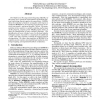Free Online Productivity Tools
i2Speak
i2Symbol
i2OCR
iTex2Img
iWeb2Print
iWeb2Shot
i2Type
iPdf2Split
iPdf2Merge
i2Bopomofo
i2Arabic
i2Style
i2Image
i2PDF
iLatex2Rtf
Sci2ools
ICCD
1996
IEEE
1996
IEEE
Boolean Function Representation Based on Disjoint-Support Decompositions
The Multi-Level Decomposition Diagrams (MLDDs) of this paper are a canonical representation of Boolean functions expliciting disjoint-support decompositions. MLDDs allow the reduction of memory occupation with respect to traditionalROBDDs by decomposing logic functions recursively into simpler - and more sharable - blocks. The representation is less sensitive to variable ordering, and because of this property, analysis of the MLDD graphs allows at times the identification of better variable orderings. The identification of more terminal cases by Boolean algebra techniques makes it possible to compensate the additional - small- CPU time required to identify the disjoint-support decomposition. We expect the properties of MLDDs to be usefulin several contexts, most notablylogicsynthesis, technology mapping, and sequential hardware verification.
Disjoint-support Decomposition | Hardware | ICCD 1996 | Multi-Level Decomposition Diagrams | Variable Orderings |
| Added | 08 Aug 2010 |
| Updated | 08 Aug 2010 |
| Type | Conference |
| Year | 1996 |
| Where | ICCD |
| Authors | Valeria Bertacco, Maurizio Damiani |
Comments (0)

